Spongy Moth (LDD) Best Practices

Spongy Moth (LDD) Best Practices
Now that winter snow has finally melted, it is time once again to turn our attention back to very hungry caterpillars that will soon be coming to a neighbourhood or tree near you. The name may have changed from Gypsy to LDD to now Spongy Moth, but it is still the same invasive insect. Depending on the level of threat, the following is a list of comprehensive strategies that, if followed (in whole or in part), will safeguard vulnerable trees until the current infestation collapses in 1-3 years. Most of the strategies are time sensitive so, as we move into spring, it is important to get outside, enjoy some fresh air and take a good look at trees in your neighbourhood. If you see little tan coloured egg masses, then start preparing to do battle.
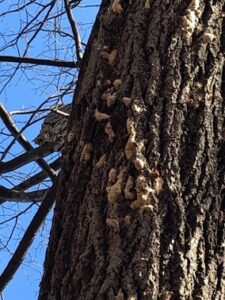 Search and Destroy Egg Masses (Sept – April)
Search and Destroy Egg Masses (Sept – April)
Egg masses are laid in mid to late summer and will remain dormant until the following spring when trees start to bud new leaves. Tan in colour, these fuzzy masses can range in size from 1-5 cm and contain between 100 to 1000 eggs, and so time spent hunting and removing them is vital. The original Gypsy Moth name was given because of their ability to travel by attaching to the underside of various movable objects such as firewood, trailers, outdoor furniture, etc. but most can be found on tree trunks and any sheltered location out of direct sun and rain.
The masses themselves are very fragile and care must be taken to remove the entire mass since eggs that fall to the ground can still hatch. This is one of the reasons why power washers or garden hoses are not recommended for removal.
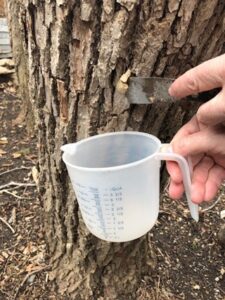
Areas of low infestation: If there are only a few egg masses present, they are just as important to find and remove since this can slow or even eliminate new pockets of infestation from becoming established. Using a dull knife, scrape the mass into a plastic container and use an old toothbrush to clean up any remaining residue. The small eggs are close to the surface on which the mass is laid so give it a good brush especially on rough surfaces with crevices. Once collected, it is critically important to destroy the eggs by soaking them in soapy water or bleach for several days before disposal.
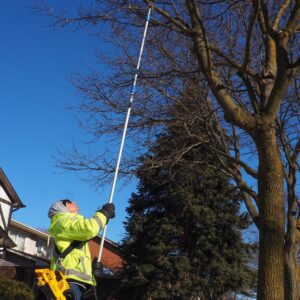
Areas of high infestation: If infested trees are far from a power source them scraping is effective but time consuming. For urban locations within reach of an extension cord a wet/dry vacuum with a filter bag and crevice attachment is highly recommended. The shopvac removes the entire mass in a fraction of the time. For awkward hard to reach masses that are low to the ground or overhead, nothing gets left behind. For high tree locations or under the eaves of homes, a modified extension pole can be added, eliminating the need for ladders. A 20-foot (or longer) window cleaning extension pole can be purchased online, or a 16-foot pool skimmer extension pole can be purchased at Canadian Tire for roughly $30. Cut the ends and wrap with tape to fit the vacuum hose. This method of removal with cordless vacuums is currently being utilized by various municipalities. Since one vacuum can quickly clean up multiple properties, consider getting together with neighbours to share both equipment cost and labour. As with hand scraping, it is even more vital that once the vacuum bag is full, it is soaked in soapy water or bleach until all eggs are killed before disposal.
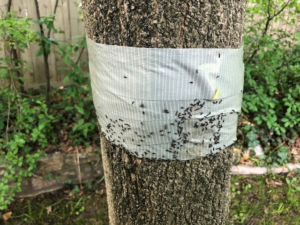
Taping Trees (Late April) Before the hatch, tape all vulnerable trees to prevent ground level 1st instar caterpillars from ever reaching the tree canopy. On rough tree bark, it is recommended to first apply a strip of polyester batting to fill in voids. Secure the strip with one tight band of duct tape sticky side in. The batting can be purchased from Fabricland or ordered online and cut into approx. 2” wide strips. Next apply a 4 to 6 inch wide band of all-weather exterior duct tape, sticky side out. Not all duct tapes are the same so make sure you use a tape made for exterior use so it will remain sticky for several weeks. This band forms an impassible barrier for young caterpillars many of which will just crawl onto the tape and get stuck. Later in the season if the tape does lose its stickiness and larger caterpillars attempt to cross, products like Tanglefoot can be applied to again make the tape impassible. Some conservation authorities are advising against the use of sticky bands though their concerns relate primarily to bands made from very adhesive fly paper like material that can sometimes trap birds and small mammals.
Note: Batting is not required when taping smooth bark trees and if exterior duct tape is not available some experts suggest taping with plastic food wrap coated in Vaseline or lard. This method is effective though unsightly since it is much wider and collects more debris over the summer months.
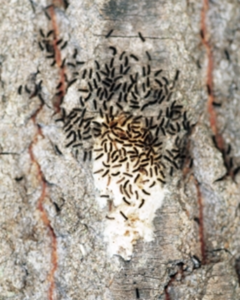
Day of the Hatch (Late April to Early May) In this region hatching normally begins early May coinciding with the emergence of new tree leaves. Depending on environmental conditions like a warm dry spring and the specific location of the egg mass (sunny fence vs. shady rock), timing can vary. When caterpillars first hatch, they often remain clustered around egg masses for the first 24 hrs, making hidden masses much easier to spot. Strong pesticides are not recommended for LDD moths because they also kill beneficial insects and parasitoids that feed on caterpillars. However, on this one day, blasting hundreds of clustered tiny caterpillars with a single shot of Raid is advisable and forgivable. This is very time sensitive since they can disperse at any time so be on the lookout. Unfortunately, not all newly hatched caterpillars can be intercepted. Once on the move, they are drawn towards light and will climb upward searching for new leaves. If they climb to the top of an untaped tree and it is a host species they prefer, they will settle in and begin feeding. If they climb a house, light pole, tall fence, or tree species that they do not feed on, then the tiny caterpillars drop down on a silken thread and let the wind balloon them to a new location. This process repeats until the caterpillar finds an appropriate host or perishes within approx. 7 days. This is one good reason to hope for calm rainy weather during hatching because caterpillars can balloon many kilometers though most only travel very short distances.
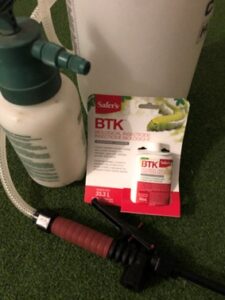
Spraying Btk (Mid May) Bacillus thuringiensis kurstaki (Btk) is a naturally occurring soil bacterium that affects the digestive system of leaf eating caterpillars and is not harmful to other insects or mammals. Once ingested, a young caterpillar stops feeding and dies within days. When in stock, it can be purchased in a concentrated form at most garden supply stores. Starting mid to late May, spray Btk on reachable foliage of vulnerable trees. Repeat weekly or after heavy rain for 3-4 weeks. Cities like Toronto that have well established control programs, do aerial spraying of Btk over heavily infested areas.
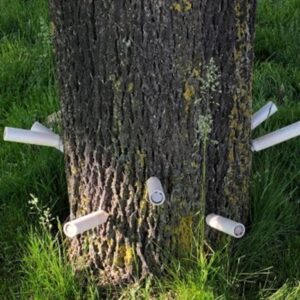
Injecting TreeAzin (Mid May) For certain high value, vulnerable, or previously stressed trees it is possible to inoculate with a product called TreeAzin. This is the same product and method used to treat for the Emerald Ash Borer. When injected under the bark, the trees’ arteries carry this natural product up into the leaves and it acts much like Btk. For very tall trees unreachable by ground spraying and in the absence of aerial Btk spraying, this expensive treatment can be a good option for some property owners wanting to protect high value trees.
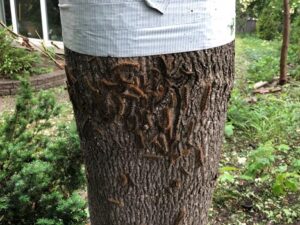 Collecting Caterpillars (Early June – mid July) As summer temperatures increase, maturing caterpillars begin to move down out of the canopy in the early morning to escape heat and predators and climb back up in the evening to feed throughout the night. On taped trees they are blocked from climbing and can easily be collected each day as they gather below the tape. There are various good methods of collection but since the caterpillar’s small hairs can cause an allergic reaction it is advisable to never touch with exposed skin. One of the caterpillar’s natural defenses actually works in your favour. When disturbed by a potential predator the caterpillar will just drop to the ground. By placing a container (recommend a plastic measuring cup with a handle) filled with an inch or two of soapy water under the caterpillar and brushing it lightly (recommend a stiff long handle artists brush for better reach), the caterpillar will just drop into the container. The soap in the water lessens the surface tension and the caterpillar sinks to the bottom and drowns. During times of very heavy infestation, a shopvac can be used to suck up caterpillars. Smelly but very effective.
Collecting Caterpillars (Early June – mid July) As summer temperatures increase, maturing caterpillars begin to move down out of the canopy in the early morning to escape heat and predators and climb back up in the evening to feed throughout the night. On taped trees they are blocked from climbing and can easily be collected each day as they gather below the tape. There are various good methods of collection but since the caterpillar’s small hairs can cause an allergic reaction it is advisable to never touch with exposed skin. One of the caterpillar’s natural defenses actually works in your favour. When disturbed by a potential predator the caterpillar will just drop to the ground. By placing a container (recommend a plastic measuring cup with a handle) filled with an inch or two of soapy water under the caterpillar and brushing it lightly (recommend a stiff long handle artists brush for better reach), the caterpillar will just drop into the container. The soap in the water lessens the surface tension and the caterpillar sinks to the bottom and drowns. During times of very heavy infestation, a shopvac can be used to suck up caterpillars. Smelly but very effective.
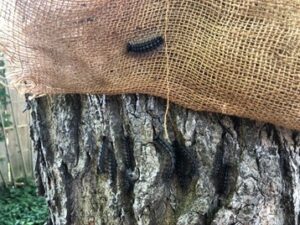
Burlap Traps (Early June) For trees that have not been taped or have signs of feeding above the tape by caterpillars that have ballooned in or dropped from surrounding trees, it is time to wrap. On taped trees, the duct tape bands stop caterpillars already in the canopy from reaching the ground and many just turn around and head back up. Some experts recommend removing the tape for this reason but if the tape is still sticky (e.g. with supplemental Tanglefoot), then it is recommended to place the burlap above the tape for double protection. Daily or as often as desired, clean up caterpillars gathering under the burlap and below the tape. Towards the end of the season, if caterpillars are dying under the burlap from virus or fungus (explanation to follow), consider leaving all in place to spread infection.
How to wrap: Measure the tree’s circumference with twine and then using the twine, cut burlap to size. Wrap the tree and tie the twine tightly just below centre of the burlap. Fold the top down over the bottom forming an overlapping skirt. The caterpillars can climb down over the wrap but get trapped in the folds on the way back up. Fabric other than burlap can be used but burlap is the most effective since the caterpillar’s hairs get snagged by the burlap’s loose fibres.
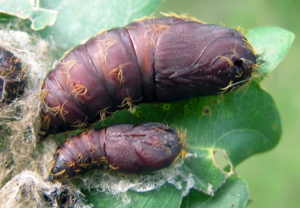
Pupae Clean Up (Mid-June-July) Exactly when caterpillars begin to pupate depends on a variety of factors. If the weather is dry and cool and caterpillar numbers are so great that they overwhelm predators, caterpillars can feed continuously 24/7 maturing in mid-June. If conditions are less favourable, it can occur much later. The male caterpillars go through 5 stages of development called instars and females go through 6 instars taking an extra 7-10 days to mature. This is why most of the really big caterpillars you see at the end of the season are female. They form larger pupae and since each female moth can potentially represent 400+ new caterpillars, it is these pupae that are the most valuable to destroy. Again, a shopvac is an excellent tool for collecting the pupae. Burlap can be removed at this point but leave the tape up to stop late season stragglers. If you have a lot of burlap laden with live pupae, line a trash pail with trash bag and place burlap inside. Move the pail to a suitable location and fill with soapy water to cover. After several days, tip the pail to drain, tie off the bag and you are ready for disposal.
What Not to Clean Up (Late June-July) No matter how many egg masses or caterpillars you destroy once LDD moths are established in an area, the best you can do is lessen the permanent damage done to trees until naturally occurring or introduced control measures collapse the population. It is also the presence of these controls in the environment that suppress caterpillar populations long-term, ensuring new infestations cannot reoccur for many years. So what shouldn’t you clean up?
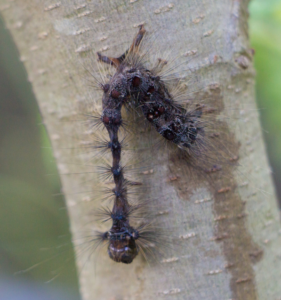
Dead caterpillars hanging in an upside down ‘V’: This caterpillar has died from the NPV virus which is highly infectious and kills up to 75% of caterpillars under dense population conditions. Interesting fact: This virus changes the caterpillar’s behaviour causing it to climb high before it dies. The cadavers liquify, raining down virus on leaves and caterpillars below.
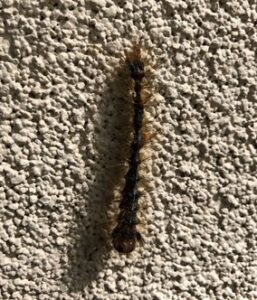
Dead shrivelled caterpillars hanging head down: This caterpillar has died from E. maimaiga or ‘insect eater’ fungus. First introduced to North America from Japan, it is present in the soil and, under the right weather conditions, kills caterpillars throughout the summer. Decomposing caterpillars release overwintering spores back into the soil for next spring.
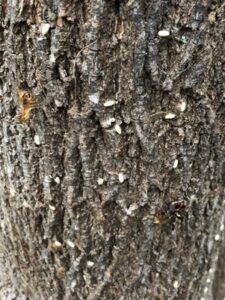
Small yellowish rice sized cocoons: These belong to parasitic wasps that attack only young caterpillars.
Stinkbugs, spiders, and beetles of various description: All are active predators of LDD caterpillars during different stages of development.
In combination, all of these insect predators, parasitoids, and pathogens along with birds and mammals are what collapses LDD populations within 1-3 years of an outbreak and keeps caterpillar numbers in check between sporadic infestations. It is also why the use of broadband pesticides is strongly discouraged because their use can actually extend the length of an infestation.
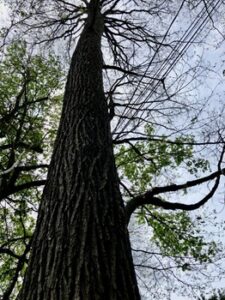
Helping Trees Recover (June – Sept) The goal of all LDD control efforts is to lessen stress on trees so that they can fully recover. If defoliation occurs early in the summer most deciduous trees can “reflush” new leaves. However, this often requires more energy than the new leaves produce. The application of fertilizer immediately after defoliation actually encourages a larger flush of new growth further depleting the trees’ reserves. What the trees need most is the lessening of other stresses. During periods of drought, water affected trees heavily once per week and avoid compressing or disturbing soil around their root systems. A well-balanced fertilizer can be applied very late in the fall to give trees a boost for the following spring. For particularly hard-hit prominent trees, consider aggressive Btk spraying or TreeAzin injections for the following spring since repeated heavy defoliations can eventually kill even the strongest tree.
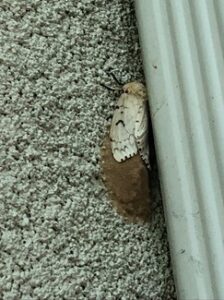
Females Emerge (Early July) – As female moths begin to emerge, destroy them before they mate or finish laying eggs. A sharp stick works well at ground level and a shopvac with extension pole is highly efficient sucking up those overhead. The highly visible white females remain stationary for several days while laying so they and their new eggs are easier targets than egg masses alone.
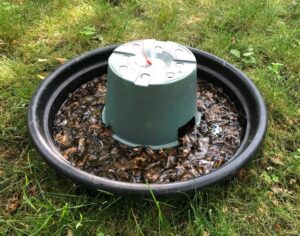
Pheromone Traps (July)There is conflicting information as to the effectiveness of pheromone traps in reducing the scale of a localized infestation. Commercial traps are extremely expensive when considering the relative few male moths they trap. If high potency pheromone baits can be acquired and used in DIY (Do It Yourself) Pan or Bottle traps, then the cost per male moth killed drops dramatically but it is still not a very effective control measure since even one male can fertilize multiple females. In areas of high infestation, pheromone traps do have substantial value in that they draw annoying zigzagging male moths away from people enjoying outdoor spaces.

Enjoy a Well-Earned Rest (Aug– Nov) Until the leaves fall making egg masses more visible, take some time off to consider how many trees you may have helped save. With luck the infestation will collapse this fall and hungry caterpillars will just be a bad memory next summer.